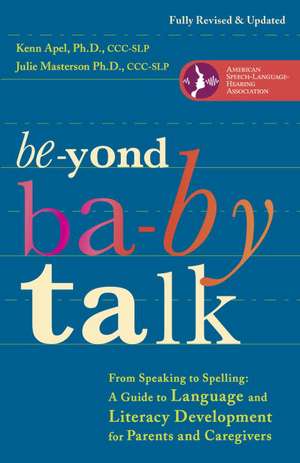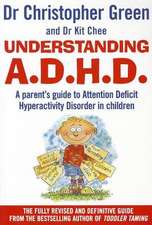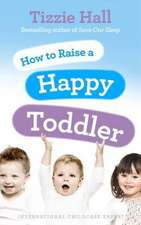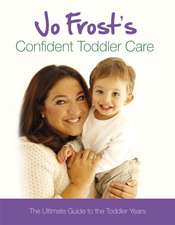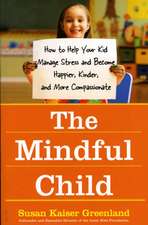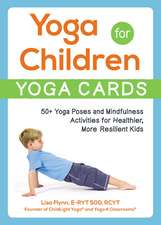Beyond Baby Talk: A Guide to Language and Literacy Development for Parents and Caregivers
Autor Kenn Apel, Julie J. Mastersonen Limba Engleză Paperback – oct 2012
Language is about so much more than just words, and healthy communication is the foundation of your child’s ability to succeed emotionally, socially, and academically. The first eight years of life are a critical period of language and literacy development, and as a parent, you are your child’s primary role model as he or she begins to acquire speaking, reading, and writing skills. And yet, you may be uncertain of what constitutes typical language progress and of what activities and practices will enhance your child’s learning experiences the most. Fully revised and updated for our modern times, Beyond Baby Talk is here to guide you through the easiest and most engaging ways to instill strong communication skills in your child, and to provide fun for you both along the way.
Inside, you’ll find all of the essential steps and checkpoints to help you gauge your child’s progress, as well as easy methods to:
• Evaluate and monitor your child’s spoken language development
• Enhance your child’s literacy skills for improved spelling, reading, and writing abilities
• Understand and navigate environmental influences on language development such as television, texting, and cultural slang
• Recognize the signs of language and literacy progress problems—and know when to seek professional help
In collaboration with and copyrighted by the American Speech-Language-Hearing Association (ASHA) www.asha.org/BeyondBabyTalk
Preț: 106.64 lei
Nou
Puncte Express: 160
Preț estimativ în valută:
20.41€ • 21.36$ • 16.98£
20.41€ • 21.36$ • 16.98£
Carte disponibilă
Livrare economică 10-24 martie
Preluare comenzi: 021 569.72.76
Specificații
ISBN-13: 9780307952288
ISBN-10: 0307952282
Pagini: 284
Dimensiuni: 203 x 188 x 16 mm
Greutate: 0.23 kg
Ediția:Revised
Editura: Three Rivers Press (NY)
ISBN-10: 0307952282
Pagini: 284
Dimensiuni: 203 x 188 x 16 mm
Greutate: 0.23 kg
Ediția:Revised
Editura: Three Rivers Press (NY)
Recenzii
"Beyond Baby Talk combines accuracy with readability to produce an excellent resource for parents, caregivers, and clinicians alike." --Arthur C. Maelender, Ph.D., Geisel School of Medicine at Dartmouth
"[Beyond Baby Talk] is well written and enjoyable to read....made concepts much easier to grasp and understand. I would definitely recommend to the families that I care for. " --Michael Metts, D.O., FAAP, FACOP, Des Moines University
"[Beyond Baby Talk] is well written and enjoyable to read....made concepts much easier to grasp and understand. I would definitely recommend to the families that I care for. " --Michael Metts, D.O., FAAP, FACOP, Des Moines University
Cuprins
Contents
How Does Your Child Hear and Talk?
Acknowledgments
Introduction
1. Getting Started: How You and Your Infant Create Language Together
2. Earliest Words: Discovering Your Baby’s Style
3. Building First Sentences: Natural Ways to Encourage Your Toddler
4. Preparing for Written Language: Setting Your Preschooler on the Right Path
5. Reading, Writing, and Spelling: Helping Your Child Achieve in School
6. The Influence of Gender and Birth Order on Language Development
7. The Influence of Culture on Language
8. The Influence of Media on Language Development
9. Language Development and Child Care
10. Fads, Scams, and Myths: Knowing What to Look For
11. When You Suspect a Language Delay: Getting Help
References
Index
How Does Your Child Hear and Talk?
Acknowledgments
Introduction
1. Getting Started: How You and Your Infant Create Language Together
2. Earliest Words: Discovering Your Baby’s Style
3. Building First Sentences: Natural Ways to Encourage Your Toddler
4. Preparing for Written Language: Setting Your Preschooler on the Right Path
5. Reading, Writing, and Spelling: Helping Your Child Achieve in School
6. The Influence of Gender and Birth Order on Language Development
7. The Influence of Culture on Language
8. The Influence of Media on Language Development
9. Language Development and Child Care
10. Fads, Scams, and Myths: Knowing What to Look For
11. When You Suspect a Language Delay: Getting Help
References
Index
Notă biografică
Kenn Apel, PhD, CCC-SLP, is a professor and chair of communication sciences and disorders at the University of South Carolina and a widely known researcher and educator in language and literacy development and disorders.
Julie J. Masterson, Ph.D., CCC-SLP, is a nationally known educator and researcher in speech, language, and literacy development. She is a professor of communication sciences and disorders at Missouri State University.
Julie J. Masterson, Ph.D., CCC-SLP, is a nationally known educator and researcher in speech, language, and literacy development. She is a professor of communication sciences and disorders at Missouri State University.
Extras
chapter 1
Getting Started: How You and Your Infant Create Language Together
Did You Know?
• At birth, infants prefer their mothers’ voices to other women’s voices.
• To an infant, the human face is a fascinating object.
• Infants can express many desires and wants before they can talk.
As young, first-time parents, Jim and Karen were relatively calm and self-assured in their parenting skills for their infant daughter. Three weeks after their daughter’s birth, Karen and the baby had a nursing schedule set, and Jim was fast becoming an expert diapering service. They marveled over how beautiful their daughter was and wondered what her voice would be like when she began to talk. They knew children did not talk until about age one, and they were anxious to begin communicating with their little one. However, during that third week, something interesting happened. As Jim was changing her diapers, she smiled. He also noticed that her eyes seemed to brighten when Karen spoke from the other room. Suddenly he realized that his little girl was actually communicating already!
Believe it or not, this first year of life will contain one of the greatest accomplishments of your infant’s life. It is during this first year that she will catch on to the notion of communicating. She will learn to take control of her mouth, forming the sounds of language that will serve her well as she begins to talk. She will learn to relate her needs in more predictable ways that can be easily understood by you. She will develop, in essence, the foundation for all future language learning. And your part in this learning is vital. As you will see, your actions and interactions with her will help her catch on to this incredible communication tool: language.
What Is Language?
The quality of your child’s life is dependent, to a great extent, on her ability to communicate. Language permeates all aspects of her experience; it’s an essential part of her being, how she connects with others, expresses herself, and gets the care she needs. Language is also important because it’s your window into your child’s personality—her words let you in on her thoughts and feelings. Through language, you are able to guide and influence your child and pass your values on to her.
So what is language? Language is composed of six systems or aspects of communication, all equally important, all different from one another. These systems include sound, meaning, word order, grammar, letters and letter patterns, and the social uses of language. Taken as a whole, they represent the rules we must follow when we communicate so that others will understand us and make sense of what we are saying.
The Sound System: Phonology
The first language system deals with the speech sounds that we all use when we speak. This aspect of language is formally called phonology. When we speak, we use certain sounds that are accepted by our listeners as valid sounds for communicating. So, for example, we use speech sounds such as p, d, k, s, sh, and n. These speech sounds are the building blocks for exchanging information among individuals. There are other sounds we could make, but if they are not part of the meaningful words that we use to convey meaning, then they are not speech sounds.
The quality of your child’s life is dependent, to a great extent, on her ability to communicate.
Some speech sounds we make are not speech sounds in other languages, and some other languages use sounds that are not speech sounds in our language. For example, Spanish has a trilled r sound, whereas English does not. Further, differences that are important in one language may not be important in another. For instance, the difference between the vowel sounds in seat and sit is important in English. Changing from one to another can result in different words (beat/bit; seen/sin; leap/lip). However, this difference is not important in Spanish, which is one of the reasons why native Spanish speakers struggle with those sounds in English and pronounce some of the i words with an ee sound (feet for fit). Children acquiring the sound system of their language must learn which sound differences are important (and worthy of attention) and which ones are not (and can be ignored).
It’s important here that you understand that we are talking about sounds, not letters (we will talk about those later). For adults, this is sometimes confusing, because we are so used to thinking about words as made up of letters. The danger to thinking of speech sounds as letters is that sometimes speech sounds are represented by two letters. We write the word bath using four letters, but when we say bath, we hear only three speech sounds—b, a, th. On the other hand, the letter x is just one letter, but when it is said in a word, it represents two sounds—k and s, as in box (b-o-k-s).
Thus, when we are talking about children’s developing language skills, we are including in that discussion how they learn to articulate or pronounce the sounds that make up their language. As you will see, children must come to understand that certain rules must be followed when speaking. These rules involve including all speech sounds that should be in a word and using them in the right places of the word, and not adding or using speech sounds that should not be in a word.
Of course, not everyone will use speech sounds when communicating or using language. Some individuals will use sign language to convey their thoughts and ideas. In this case, then, the aspect of language that involves speech sounds is replaced by the system of hand gestures, movements, and placement around the body. This gestural system is equivalent and as important to communicating through sign language as sounds are for spoken language. The speech sound system is the only component of language that is not shared between spoken language and sign language. The remaining systems are found in both types of language.
In the first four to five years, children will be learning how to produce correctly the speech sounds of their language(s). They won’t be conscious that they are learning their sounds, though; it will happen somewhat subconsciously. However, as you will learn in chapter 4, there will come a point, usually around the age of four or five, when they will start thinking about speech sounds. This actually is great because being able to think about speech sounds is highly important in the process of learning to read and spell words. So, as you will see, speech sounds are important for both spoken and written language development.
The Meaning System: Semantics
Children learn very early in development that they can use words to express lots of different ideas and concepts that they have to offer. As you will see in chapter 2, when your child first learns to talk, he will use several types of words. These words will allow him to discuss actions, request help, comment on passing objects or people, and greet you as you come in the door. He will do this with a set of words that, although limited at first, expands dramatically over the first five years. Thus, semantics involves both general types of words and the meanings of individual words.
Many people, including some educators, pediatricians, and caregivers, seem to think of early language as though it were synonymous with semantics, the meaning system of language. Often, it seems people talk about language as lists of concepts like colors and numbers; the more concepts a child knows, the better and more advanced his language is. However, as you are learning in this chapter, language involves a whole lot more in addition to vocabulary and concepts. In addition, semantics is more than just the words and concepts children use when they speak. As children learn to read and spell, they also will learn that meaning affects spelling (and vice versa). For example, if a child wants to write about a large animal in the words, she will need to develop an understanding that she must write bear, not bare, to get across her correct message to her readers. What’s the bottom line message for semantics? It is an important language skill that, along with other language skills, allows children to communicate their message in a meaningful way.
The Systems for Word Order and Grammar: Syntax and Morphology
Some of you may recall learning Spanish, remembering how confusing it was at first that the order of words was different for English than it was for Spanish. We might say, “I see a red car” in English, but in Spanish, we would say, “Yo veo un coche rojo” (I see a car red).
Word order is different for each language. Within each language, we need to follow the rules for which words go where in spoken, and written, sentences. It would not do to talk to others in English using Spanish word order. Imagine the confused looks on others’ faces if we didn’t include the subject pronoun and put the adjective after the verb in declarative sentences! The system that provides the rules for word order, syntax, is highly structured and rigid. As your child develops language, she will need to learn the rules for how to order her words and what word orderings are allowable. It is quite the task considering no one actually will sit down and tell her which words to put where in a sentence. In addition, once she starts to read, she will learn more complicated and less familiar rules of word order that only seem to appear in books.
Besides word order, we also need to think about the endings and beginnings we attach to basic words and the “filler” words that help us link thoughts across sentences. The term grammar, or morphology, as we call it, is often used when describing the aspect of the language system that dictates how we let others know about the number of objects we are discussing (two cats), whether we are talking about events in the past, present, or future (I jumped over the fence), the direction of a moving object (The dog ran around the house), and how to make the subject of the sentence “agree” with the action of the sentence (She sings; they sing). The grammar of a language is complex, containing many dos and don’ts. It is not uncommon to hear someone refer to “proper grammar” or comment that an individual’s sentence was “grammatically incorrect.” While as an adult you may take grammar for granted, we think you will be amazed when you read how children learn this rule system for both spoken and written language with remarkable ease and speed.
The Letter System: Orthography
We use spoken words to communicate our thoughts verbally; we use written words to communicate our thoughts in print. Written words are made up of combinations of letters, which follow very specific rules and patterns. This is a good thing because learning written language would be extremely difficult, if not impossible, without a rule-governed system to guide us. We use the term orthography, which literally means to “write correctly,” to talk about this rule system that determines how and why we write words the way we do.
One aspect of orthography is simply knowing what letter or letters represent the sounds we use in our spoken language. We call this knowledge of letterߝsound correspondence, or alphabetic knowledge. For example, we know when we hear the speech sound b, we can write the letter b, or sometimes bb, like in bubble. Some speech sounds only have one or two letters that represent them, and others have many possible letter(s) (e.g., the speech sound k can be spelled with the letters c, k, ck, ch, and so on). Alphabetic knowledge also includes the opposite: knowing what speech sounds letters can make. For example, when we see the letters ch, we know they can make the k sound or the ch sound. Having this alphabetic knowledge is highly important to reading and spelling words we don’t know automatically from memory.
Orthographic knowledge goes beyond just knowing letterߝsound correspondence. It also includes other rules for how we put our speech down into print. For example, children must learn that certain letters can never occur in specific places within a word (the tch letter combination can be used in the middle and end of words, but it can never be in the beginning of a word). Children also learn that some letter combinations can never occur any place in a word, such as writing the kr letter combination to represent the kr sounds, unless it is in a person’s name, such as Kristen (or a certain donut company!). Finally, children also learn that there are rules for when one uses certain letters because of the other sounds in words. As a case in point, children need to learn that we use a single consonant in the middle of a word that has a long vowel (later) but a double consonant in the middle of a word that has a short vowel (latter).
As you can see, orthography is a pretty complex system that children must learn, and it is not surprising that that learning occurs once they have acquired a fair amount of their spoken language skills. Figuring out these rules is not an easy task, and even though a lot of that learning will occur between the ages of four and eight, children continue to learn them well beyond their first eight years. We will talk much more about orthography in chapters 4 and 5.
The System of Social Language: Pragmatics
Language does not exist in a vacuum. It would make no sense for an individual to have perfect knowledge of the sound, meaning, word order, letter patterns, and grammar systems of a language if that person never used that knowledge to communicate with other human beings. Thus, a very important system of language—pragmatics, or how we use language to socialize—must be learned as well.
In the first eight years of his life, your child will learn the many different reasons that humans talk, such as to inform, to question, to warn, and so on. He will learn that he needs to follow specific social rules when talking with others, such as taking turns in conversations, making eye contact with the other person, and revising what he has said when his listener is confused. He also will develop the ability to change the way he talks, depending on who he’s talking to. He will talk “politely” to his grandparents and talk “babyish” to his younger sister. Further, he will learn how to ensure his readers understand why he has written what he has on paper or the computer screen. When children demonstrate these skills, plus many more, it attests to the fact that they have learned the rules for how we socialize and interact with others using language.
Getting Started: How You and Your Infant Create Language Together
Did You Know?
• At birth, infants prefer their mothers’ voices to other women’s voices.
• To an infant, the human face is a fascinating object.
• Infants can express many desires and wants before they can talk.
As young, first-time parents, Jim and Karen were relatively calm and self-assured in their parenting skills for their infant daughter. Three weeks after their daughter’s birth, Karen and the baby had a nursing schedule set, and Jim was fast becoming an expert diapering service. They marveled over how beautiful their daughter was and wondered what her voice would be like when she began to talk. They knew children did not talk until about age one, and they were anxious to begin communicating with their little one. However, during that third week, something interesting happened. As Jim was changing her diapers, she smiled. He also noticed that her eyes seemed to brighten when Karen spoke from the other room. Suddenly he realized that his little girl was actually communicating already!
Believe it or not, this first year of life will contain one of the greatest accomplishments of your infant’s life. It is during this first year that she will catch on to the notion of communicating. She will learn to take control of her mouth, forming the sounds of language that will serve her well as she begins to talk. She will learn to relate her needs in more predictable ways that can be easily understood by you. She will develop, in essence, the foundation for all future language learning. And your part in this learning is vital. As you will see, your actions and interactions with her will help her catch on to this incredible communication tool: language.
What Is Language?
The quality of your child’s life is dependent, to a great extent, on her ability to communicate. Language permeates all aspects of her experience; it’s an essential part of her being, how she connects with others, expresses herself, and gets the care she needs. Language is also important because it’s your window into your child’s personality—her words let you in on her thoughts and feelings. Through language, you are able to guide and influence your child and pass your values on to her.
So what is language? Language is composed of six systems or aspects of communication, all equally important, all different from one another. These systems include sound, meaning, word order, grammar, letters and letter patterns, and the social uses of language. Taken as a whole, they represent the rules we must follow when we communicate so that others will understand us and make sense of what we are saying.
The Sound System: Phonology
The first language system deals with the speech sounds that we all use when we speak. This aspect of language is formally called phonology. When we speak, we use certain sounds that are accepted by our listeners as valid sounds for communicating. So, for example, we use speech sounds such as p, d, k, s, sh, and n. These speech sounds are the building blocks for exchanging information among individuals. There are other sounds we could make, but if they are not part of the meaningful words that we use to convey meaning, then they are not speech sounds.
The quality of your child’s life is dependent, to a great extent, on her ability to communicate.
Some speech sounds we make are not speech sounds in other languages, and some other languages use sounds that are not speech sounds in our language. For example, Spanish has a trilled r sound, whereas English does not. Further, differences that are important in one language may not be important in another. For instance, the difference between the vowel sounds in seat and sit is important in English. Changing from one to another can result in different words (beat/bit; seen/sin; leap/lip). However, this difference is not important in Spanish, which is one of the reasons why native Spanish speakers struggle with those sounds in English and pronounce some of the i words with an ee sound (feet for fit). Children acquiring the sound system of their language must learn which sound differences are important (and worthy of attention) and which ones are not (and can be ignored).
It’s important here that you understand that we are talking about sounds, not letters (we will talk about those later). For adults, this is sometimes confusing, because we are so used to thinking about words as made up of letters. The danger to thinking of speech sounds as letters is that sometimes speech sounds are represented by two letters. We write the word bath using four letters, but when we say bath, we hear only three speech sounds—b, a, th. On the other hand, the letter x is just one letter, but when it is said in a word, it represents two sounds—k and s, as in box (b-o-k-s).
Thus, when we are talking about children’s developing language skills, we are including in that discussion how they learn to articulate or pronounce the sounds that make up their language. As you will see, children must come to understand that certain rules must be followed when speaking. These rules involve including all speech sounds that should be in a word and using them in the right places of the word, and not adding or using speech sounds that should not be in a word.
Of course, not everyone will use speech sounds when communicating or using language. Some individuals will use sign language to convey their thoughts and ideas. In this case, then, the aspect of language that involves speech sounds is replaced by the system of hand gestures, movements, and placement around the body. This gestural system is equivalent and as important to communicating through sign language as sounds are for spoken language. The speech sound system is the only component of language that is not shared between spoken language and sign language. The remaining systems are found in both types of language.
In the first four to five years, children will be learning how to produce correctly the speech sounds of their language(s). They won’t be conscious that they are learning their sounds, though; it will happen somewhat subconsciously. However, as you will learn in chapter 4, there will come a point, usually around the age of four or five, when they will start thinking about speech sounds. This actually is great because being able to think about speech sounds is highly important in the process of learning to read and spell words. So, as you will see, speech sounds are important for both spoken and written language development.
The Meaning System: Semantics
Children learn very early in development that they can use words to express lots of different ideas and concepts that they have to offer. As you will see in chapter 2, when your child first learns to talk, he will use several types of words. These words will allow him to discuss actions, request help, comment on passing objects or people, and greet you as you come in the door. He will do this with a set of words that, although limited at first, expands dramatically over the first five years. Thus, semantics involves both general types of words and the meanings of individual words.
Many people, including some educators, pediatricians, and caregivers, seem to think of early language as though it were synonymous with semantics, the meaning system of language. Often, it seems people talk about language as lists of concepts like colors and numbers; the more concepts a child knows, the better and more advanced his language is. However, as you are learning in this chapter, language involves a whole lot more in addition to vocabulary and concepts. In addition, semantics is more than just the words and concepts children use when they speak. As children learn to read and spell, they also will learn that meaning affects spelling (and vice versa). For example, if a child wants to write about a large animal in the words, she will need to develop an understanding that she must write bear, not bare, to get across her correct message to her readers. What’s the bottom line message for semantics? It is an important language skill that, along with other language skills, allows children to communicate their message in a meaningful way.
The Systems for Word Order and Grammar: Syntax and Morphology
Some of you may recall learning Spanish, remembering how confusing it was at first that the order of words was different for English than it was for Spanish. We might say, “I see a red car” in English, but in Spanish, we would say, “Yo veo un coche rojo” (I see a car red).
Word order is different for each language. Within each language, we need to follow the rules for which words go where in spoken, and written, sentences. It would not do to talk to others in English using Spanish word order. Imagine the confused looks on others’ faces if we didn’t include the subject pronoun and put the adjective after the verb in declarative sentences! The system that provides the rules for word order, syntax, is highly structured and rigid. As your child develops language, she will need to learn the rules for how to order her words and what word orderings are allowable. It is quite the task considering no one actually will sit down and tell her which words to put where in a sentence. In addition, once she starts to read, she will learn more complicated and less familiar rules of word order that only seem to appear in books.
Besides word order, we also need to think about the endings and beginnings we attach to basic words and the “filler” words that help us link thoughts across sentences. The term grammar, or morphology, as we call it, is often used when describing the aspect of the language system that dictates how we let others know about the number of objects we are discussing (two cats), whether we are talking about events in the past, present, or future (I jumped over the fence), the direction of a moving object (The dog ran around the house), and how to make the subject of the sentence “agree” with the action of the sentence (She sings; they sing). The grammar of a language is complex, containing many dos and don’ts. It is not uncommon to hear someone refer to “proper grammar” or comment that an individual’s sentence was “grammatically incorrect.” While as an adult you may take grammar for granted, we think you will be amazed when you read how children learn this rule system for both spoken and written language with remarkable ease and speed.
The Letter System: Orthography
We use spoken words to communicate our thoughts verbally; we use written words to communicate our thoughts in print. Written words are made up of combinations of letters, which follow very specific rules and patterns. This is a good thing because learning written language would be extremely difficult, if not impossible, without a rule-governed system to guide us. We use the term orthography, which literally means to “write correctly,” to talk about this rule system that determines how and why we write words the way we do.
One aspect of orthography is simply knowing what letter or letters represent the sounds we use in our spoken language. We call this knowledge of letterߝsound correspondence, or alphabetic knowledge. For example, we know when we hear the speech sound b, we can write the letter b, or sometimes bb, like in bubble. Some speech sounds only have one or two letters that represent them, and others have many possible letter(s) (e.g., the speech sound k can be spelled with the letters c, k, ck, ch, and so on). Alphabetic knowledge also includes the opposite: knowing what speech sounds letters can make. For example, when we see the letters ch, we know they can make the k sound or the ch sound. Having this alphabetic knowledge is highly important to reading and spelling words we don’t know automatically from memory.
Orthographic knowledge goes beyond just knowing letterߝsound correspondence. It also includes other rules for how we put our speech down into print. For example, children must learn that certain letters can never occur in specific places within a word (the tch letter combination can be used in the middle and end of words, but it can never be in the beginning of a word). Children also learn that some letter combinations can never occur any place in a word, such as writing the kr letter combination to represent the kr sounds, unless it is in a person’s name, such as Kristen (or a certain donut company!). Finally, children also learn that there are rules for when one uses certain letters because of the other sounds in words. As a case in point, children need to learn that we use a single consonant in the middle of a word that has a long vowel (later) but a double consonant in the middle of a word that has a short vowel (latter).
As you can see, orthography is a pretty complex system that children must learn, and it is not surprising that that learning occurs once they have acquired a fair amount of their spoken language skills. Figuring out these rules is not an easy task, and even though a lot of that learning will occur between the ages of four and eight, children continue to learn them well beyond their first eight years. We will talk much more about orthography in chapters 4 and 5.
The System of Social Language: Pragmatics
Language does not exist in a vacuum. It would make no sense for an individual to have perfect knowledge of the sound, meaning, word order, letter patterns, and grammar systems of a language if that person never used that knowledge to communicate with other human beings. Thus, a very important system of language—pragmatics, or how we use language to socialize—must be learned as well.
In the first eight years of his life, your child will learn the many different reasons that humans talk, such as to inform, to question, to warn, and so on. He will learn that he needs to follow specific social rules when talking with others, such as taking turns in conversations, making eye contact with the other person, and revising what he has said when his listener is confused. He also will develop the ability to change the way he talks, depending on who he’s talking to. He will talk “politely” to his grandparents and talk “babyish” to his younger sister. Further, he will learn how to ensure his readers understand why he has written what he has on paper or the computer screen. When children demonstrate these skills, plus many more, it attests to the fact that they have learned the rules for how we socialize and interact with others using language.
